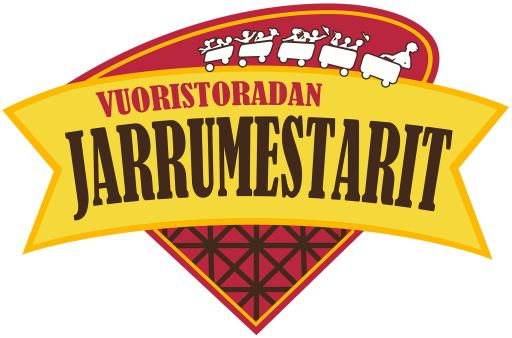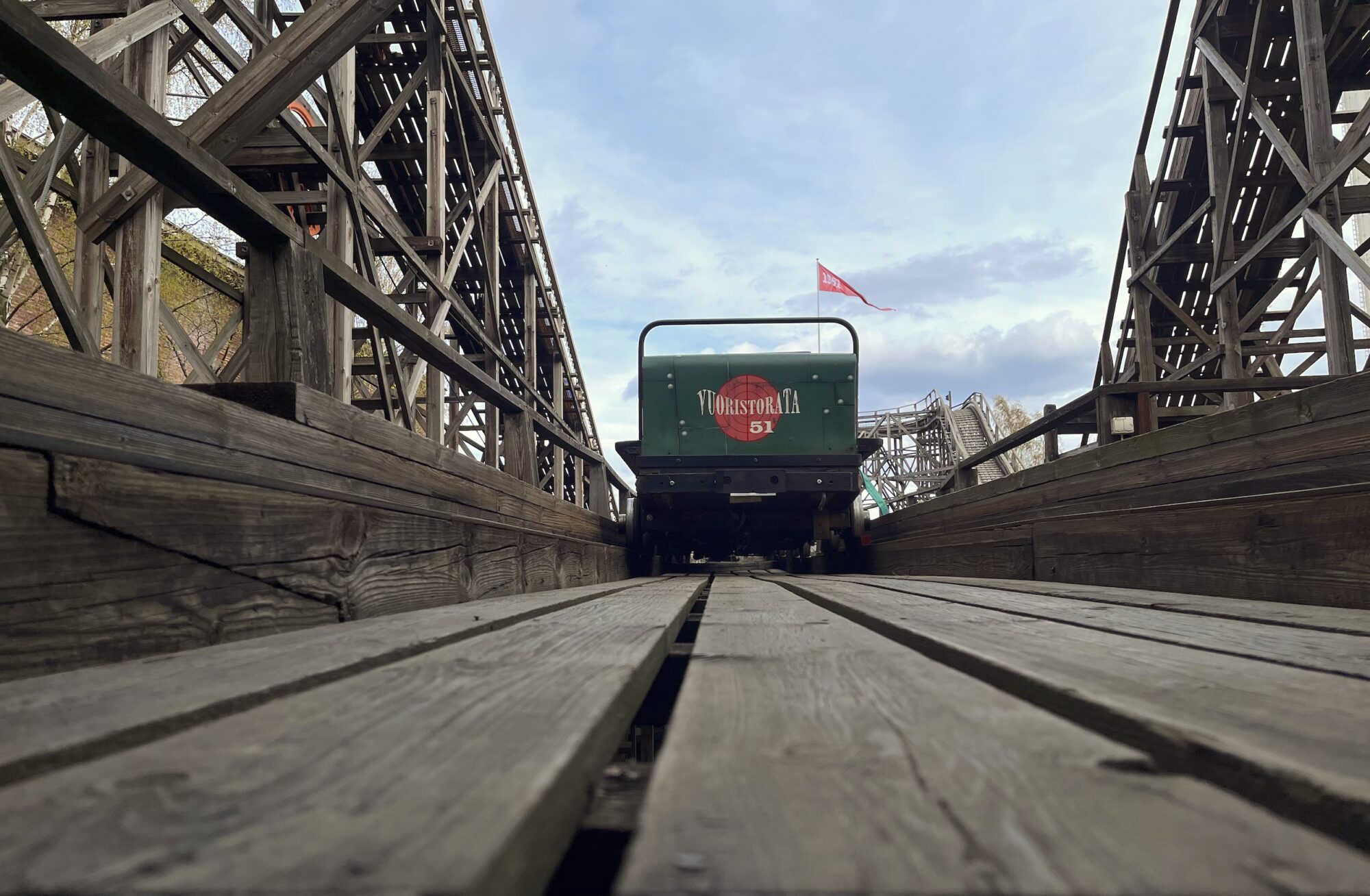Vuoristorata is one of the few remaining roller coasters in the world with trains that have manually operated brakes. Before automatic pneumatic brake systems became common on roller coasters starting in the 1960s, wooden roller coasters had either brakes operated with brake levers on the platform, or brakes built in the train operated from a brake handle located on the train. The advantage of the latter is that the roller coasters could be built with bigger hills and drops, because the speed of the train could be slowed down during the course. In addition, several trains could be sent to the track at a time, because the trains can be stopped at any time. In systems operated manually from the platform, the skid brakes that stop the train were usually at the end and on the platform, so only one train could be on the course at a time.


The concept of a brakeman-operated roller coaster was developed by the legendary American roller coaster designer LaMarcus Adna Thompson (1848–1919) at the end of the 19th century. About 50 roller coasters operating on this principle are known to have been built between 1898 and 1951 by Thompson and later by other builders, both for amusement parks and temporary exhibitions. Most of these roller coasters have since been demolished; only seven of them are left in operation, one of which is Vuoristorata. Therefore Vuoristorata is a unique amusement ride even on a global scale.
Roller coasters with brakemen in operation around the world:
- Scenic Railway – Luna Park, Melbourne, Australia (opened in 1912)
- Rutschebanen – Tivoli, Copenhagen, Denmark (1914)
- Scenic Railway – Dreamland, Margate, England (1920)
- Montaña Suiza – Parque de Atracciones Monte Igueldo, San Sebastian, Spain (1928)
- Roller Coaster – Pleasure Beach, Great Yarmouth, England (1932)
- Hochschaubahn – Prater, Vienna, Austria (1950)
- Vuoristorata – Linnanmäki, Helsinki, Finland (1951)


Although Vuoristorata was opened in 1951, it was built according to the drawings of Rutschebanen, located in Bakken amusement park in Denmark, so Vuoristorata already represented 20-year-old technology in its opening year. Danish Valdemar Lebech (1884–1975), who was responsible for the construction of Vuoristorata, was also responsible for the construction of Bakken's roller coaster in 1932 and earlier in 1914 also for the construction of Tivoli's Rutschebanen, together with an Irish engineer Walter H. Quinlan (1881–1940). The design and drawings of Tivoli's roller coaster were made by Thompson's Scenic Railway Company.
Thompson had been granted the first patent for a brakeman-operated roller coaster as early as 1892. In this first version, the brake shoes pressed against the wheels. In the next version, the brake shoes pressed downwards against the rails; in this case, the braking force depended on the mass of the train. Thompson was granted a patent for the third version in August 1913. This version was already close in principles and structure to the model according to which Vuoristorata was later built: the brake shoes were turned so that they pressed against the sides of the track, and the brakeman's position was moved from the middle of the train to its rear.
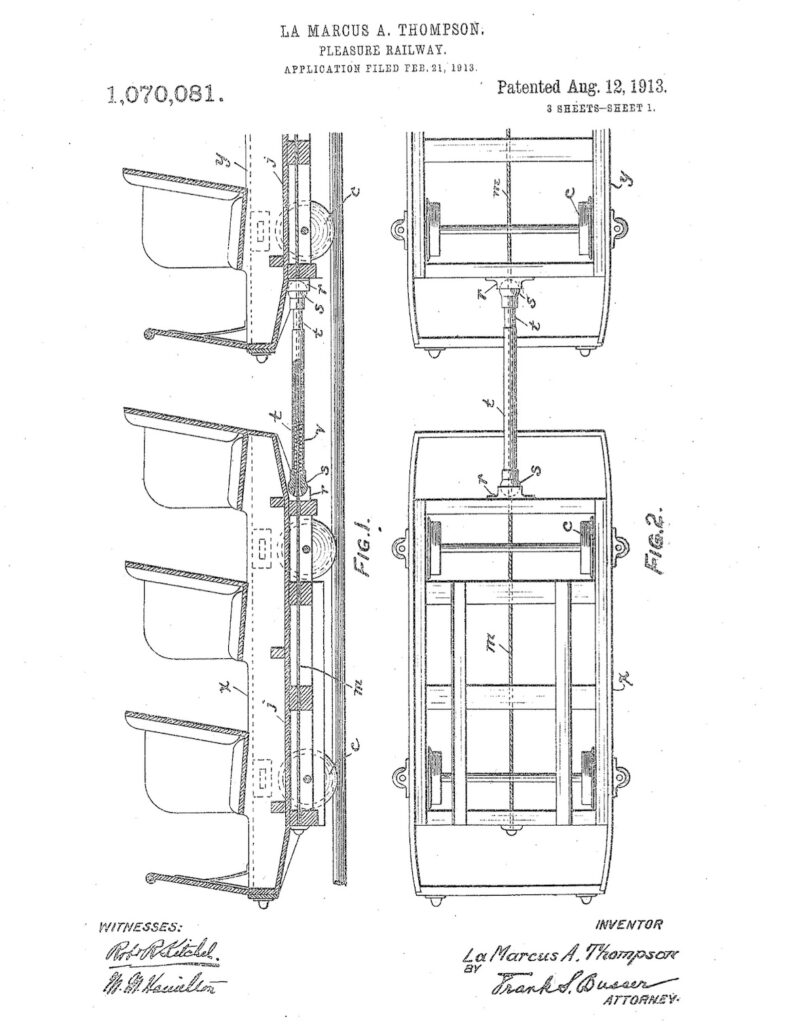
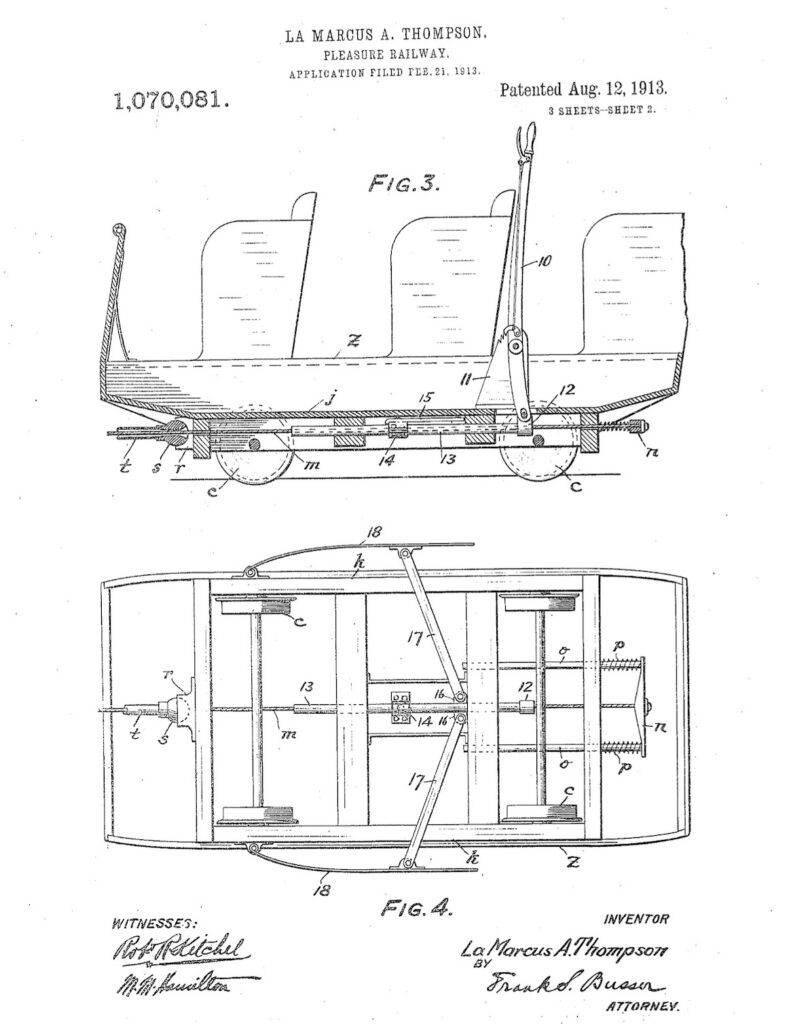
In the early 1920s, a refined roller coaster model was developed from Thompson's ideas. The train's structure was refined, locking safety bars were added, and the track and the wheels of the train were designed so that the train could not derail or jump off the rails. The original designer of these changes is not known for certain, but it is very likely that the project involved Englishman Frederick James (F.J.) Bird, who managed the London office of the Scenic Railway Company in the 1910s and later ran his own business called Amusements Construction Company in the 1920s. In 1931, Bird was responsible for the drawings for Bakken's roller coaster. The drawings modified for Vuoristorata were made by Danish architect Jürgen Adler-Nissen.

At least four roller coasters were built based on the aforementioned train and track model: Racer at Wembley Exhibition (1924, demolished in 1925), Bakken's Rutschebanen (1932, converted to use automatic braking system in 2010) and Vuoristorata in 1951; in addition, Liseberg's Bergbanan (originally built in 1923) was converted to use the new track and trains in 1952 (demolished in 1987). Of these, the only one left in its original form is Vuoristorata.


Vuoristorata in numbers
- Length of the track: 960 metres (3,150 ft)
- Height of the track: 23 metres (75.5 ft)
- Longest descent: 48 metres (158 ft)
- Top speed: approx. 60 kph (37 mph), reached during the first drop
- Average speed: approx. 20 kph (12.5 mph)
- Ride duration: approx. 2.5 minutes
- Four trains, 22 passengers per train (the number of trains in use depends on the number of customers in the park)
- Maximum capacity: 1,430 passengers per hour (when all four trains are in operation)
- A total of approx. 42,000 laps are run during the season, and up to 700 laps during one busy opening day
- Approx. 850,000 guests visit Vuoristorata every year
- In total, an estimated 50 million guests have visited Vuoristorata in the course of 75 years.

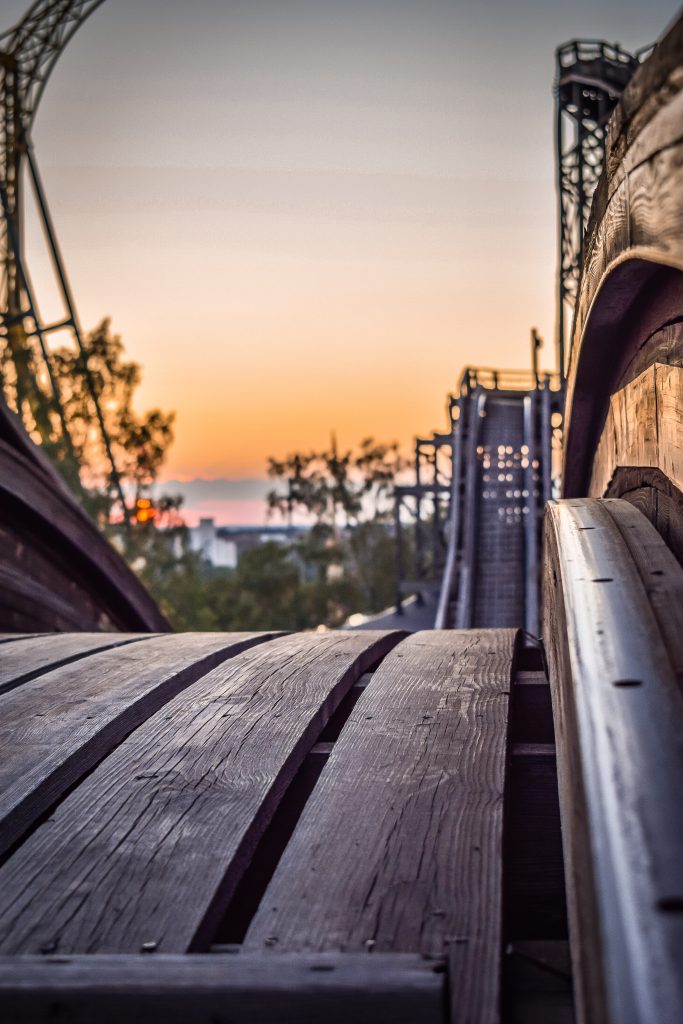
The structures of Vuoristorata are made from creosote-impregnated Finnish pine, and the structures weigh a total of about 400 tons. The 6×6-inch vertical support columns are numbered, and there are a total of 365 of them. A badge is also attached to each of them, on which the year of renewal of that part has been stamped. The vertical columns rest on concrete footers poured on the bedrock.
The structures are renewed during off-season in a certain cycle. The last original structures were replaced with new ones in 1967. All the structures have been renewed at least three times; currently the oldest structures are from 1988. In the early days, parts had to be renewed more often, but since then, thanks to high-quality impregnation, the structures have had a service life of 30–40 years.
Impregnation guarantees the wood its excellent durability in Finland's varying climate, and good-quality heartwood is already an extremely durable material by nature. For over 30 years, the lumber has been supplied by Versowood sawmill located in Vierumäki, Southern Finland.
Vuoristorata's track gauge is 1,130 mm (3 ft 8 31⁄64 in). On top of the wider lower plank, a narrower plank is attached. It has a groove into which flat steel is screwed, which acts as a rail. The side of the track, the so-called "stack", which is made by nailing five boards on top of each other, acts as a braking surface. A plywood strip is attached to the side of the stack, and it can be replaced when it wears out. The wider board on top of the stack keeps the wheels of the train under it during the course. A flat steel is also attached to the lower surface of the top board, so that the train wheel does not come into contact with the wood and wear it down.


Vuoristorata has a total of four trains. Trains are named Red, Green, Blue and Yellow according to their coloring. The first three have been in use since the beginning. The Yellow train was built later in the 1950s, when the fourth train was felt necessary e.g. for maintenance reasons. With the exception of a few minor changes, the trains' design is similar to the original.
The frames of the trains are made of oak, and the seat parts and sides are made of galvanized sheet metal, with steel reinforcement plates inside. Most of the train bodies were last renewed in the 2000s. A long tensioned steel wire runs through the train, which holds the train's four cars together. Between the cars are bars with ball-joint connections.
Vuoristorata's train is 11.5 meters (38 ft) long and weighs about 1,500 kg (3,300 lbs) empty and about 3,000 kg (6,600 lbs) with passengers.
The appearance of the trains has changed at least five times over the decades. From the end of the 1950s to the beginning of the 1970s, the front of the trains were decorated with Disney characters, after that they changed to different animals, and from the 1980s to the 2000s to clown characters. Otherwise, for the first 60 years, the trains were painted mainly with one color. The latest paintings were done one train per year between 2011 and 2014. The paintings were done with air brush technique by Jeppe Kivilaakso of FAW D-sign .

Vuoristorata's train has a total of 16 wheels. Each wheel is attached to the train's frame with a fixed axle, so the wheels do not turn. Although each car of the train is 2.6 meters (8.5 ft) long, the short wheelbase of the cars of 1,080 mm (42.5 in) ensures that the cars can travel through the curves and hills.
The wheel's flange runs inside the rail, keeping the train sideways on the track, and the wheel hub extension runs below the top plank of the side stack, so the train also cannot jump off the track during the ride.
Just like on the tramways, the rails on Vuoristorata are greased several times a week during the season; greasing reduces friction between the wheel flange and the rail, especially in the curves. This reduces noise and makes the train run more smoothly on the track.
Due to the old-fashioned wheels of the trains, Vuoristorata is classified as a scenic railway roller coaster. Therefore, there are no significant banking on the curves either. The more modern roller coasters have separate wheels above, below and on the sides of the track. Vuoristorata is the last scenic railway roller coaster ever built.
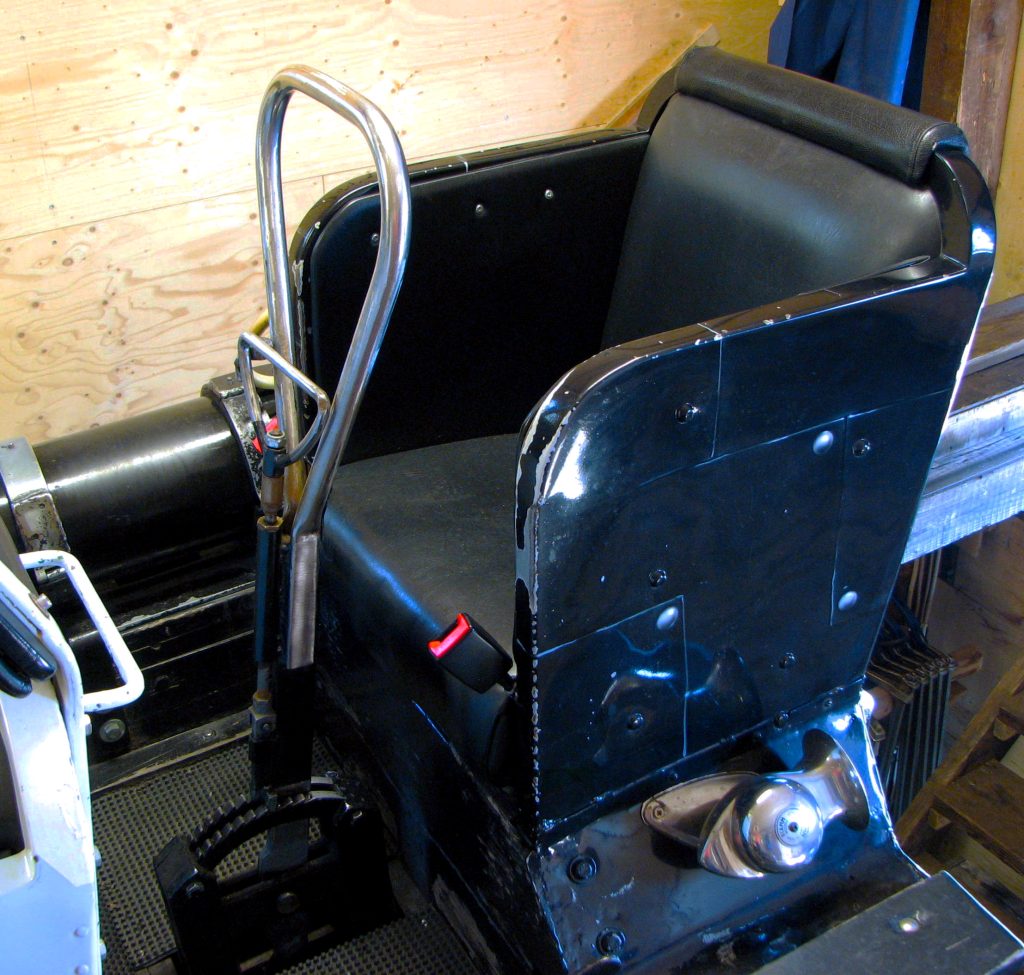
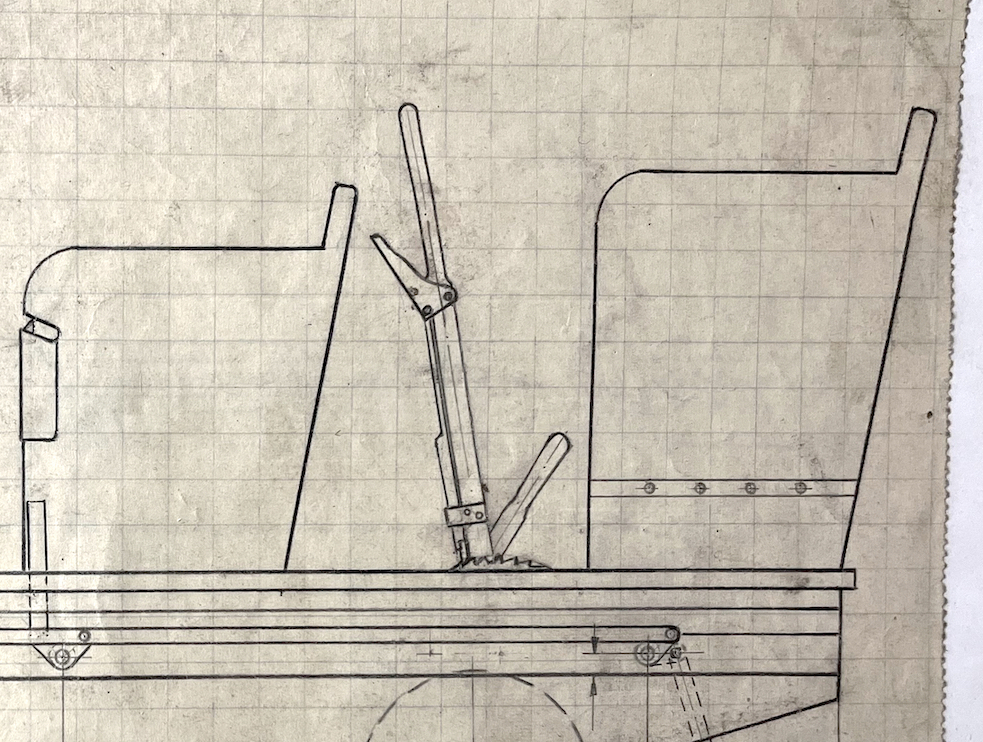
Brakemaster's most important tool is the brake lever, located at the back of the last car of the train. Using the smaller handle, the brake lever can be locked in place; the handle is attached to a spring-loaded bar, which, when in the lower position, catches the ratchet teeth at the base of the brake lever. In this case, the train remains stationary without the need for the brakemaster to manually hold the lever in the back position. When releasing the brake, the locking handle is raised and secured to the upper position, so the locking does not accidentally engage during the ride.
Although Vuoristorata's trains are basically similar, decades of operation and maintenance have made the braking feel of each train slightly different.
Because Vuoristorata's train was originally intended to be braked while in seating position, the original brake lever was a straight rod, but in 1988 it was redesigned into a loop-type handle, making braking while standing much more ergonomic. The original brake lever's locking mechanism could not be locked in the open position either, so the brakemaster had to squeeze the lock handle throughout the ride.


When the brakemaster pulls the brake lever, it moves the jointed pusher bars under the last car of the train forward. The bars push the brake shoes located between the wheels on the sides of the car outwards. Consequently, the brake shoes are pressed against the sides of the track, and the speed of the train slows down due to the friction between the brake shoes and the sides of the track. The braking system is therefore completely mechanical. The brake shoes are made of 12 mm (½ in) spring steel and weigh about 10 kg (22 lbs) each.
Behind the brake shoe is a wedge, there are two of them per car. If the train stops uphill, the wedges bite into the wooden wedge rails next to the actual rails. This prevents the train from rolling backwards. The wedges also make a recognizable tinkling sound when they hit the wedge rails on the lift hill and on every uphill.

In addition to the mechanical main brake, the train has a back-up brake system using compressed air which has been added to the trains in the mid-1960s. It can be used, for example, in the event of a main brake failure. The system was not in the original drawings, so it is designed and implemented by Linnanmäki. Originally, the backup brake on Vuoristorata was a big wooden block at the exit of the tunnel, which could be lifted and wedged against the bottom of the train using the handle on the platform if needed.
The compressed air system is operated from valves located next to the brakemaster's seat, which release air from the tank to the cylinder under the third car of the train. The piston in the cylinder pushes the brake shoes between the wheels of the third car to the sides of the track. The compressed air brake can also be activated remotely from the platform: the electric current supplied to the rails is conducted through the wheels of the last car to the solenoid control of the air brake valve, which activates the air brake.

An important part of the train's compressed air system is also the horn, which can be used to notify other trains and the brakemaster working on the platform, in a situation when, for example, a train has stopped in the middle of the course.
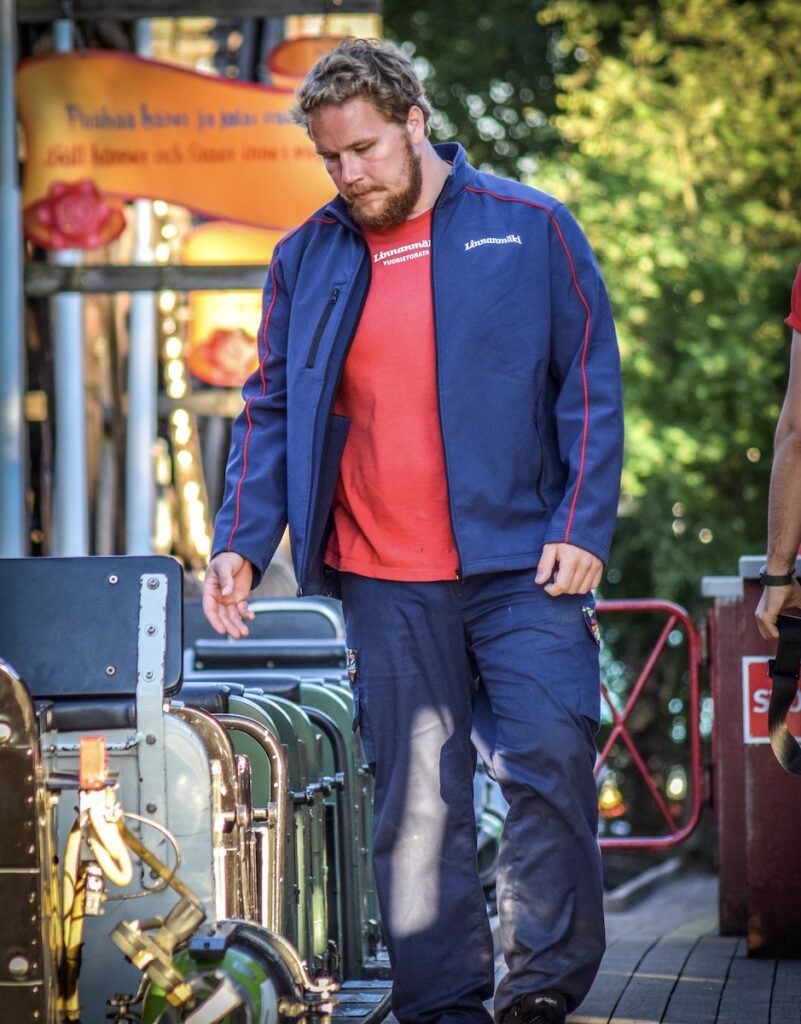
Modern roller coasters have advanced logic and automation controlling the ride. Since Vuoristorata represents the old times, operation and traffic control are done completely without the aid of computers and sensors. When the coaster is running, a brakemaster works on the platform, who is responsible for checking and giving dispatch permits the trains and managing Vuoristorata's operations. Together with the brakemasters who drive the trains, they ensure the safety of Vuoristorata and the smooth running of traffic.
The control panel located on the platform operates the lift hill motor and functions related to special situations. During normal operation, the control panel does not need to be touched at all.


Due to the ride experience which has remained original, Vuoristorata has been awarded the Coaster Classic designation by the American Coaster Enthusiasts club. The title is prestigious, given to only 30 roller coasters in the world. Vuoristorata meets the criteria for the title, which are the hallmarks of a classic wooden roller coaster:
- The trains have one-piece safety bars, shared by both passengers on one seat
- The seat is shared by both passengers, and there are no dividers between the passengers
- The cars do not have high backrests or headrests that hinder the passengers' visibility
- There are no gates or other seat-specific queuing for the train at the platform
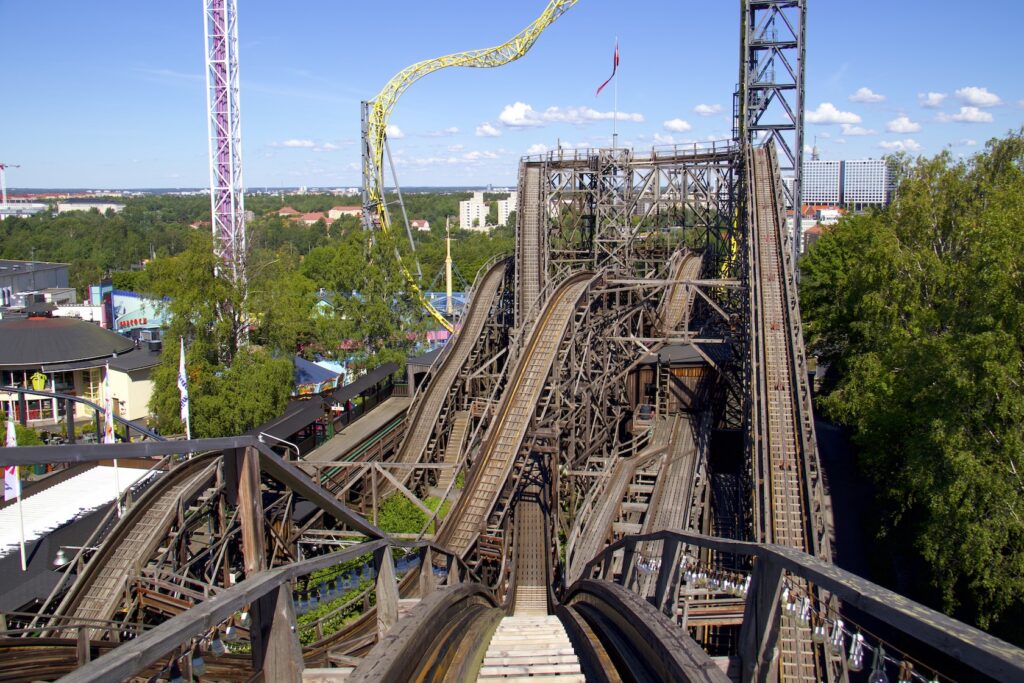
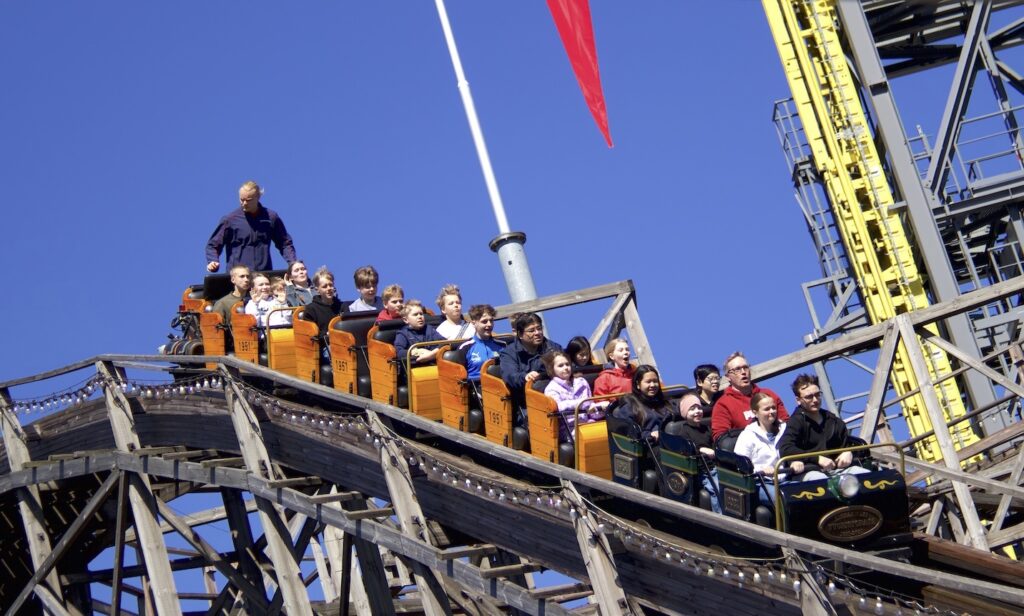
Vuoristorata works like most other roller coasters, i.e. the trains are lifted by machine power to the highest point of the track, from where they roll to the end of the track by gravity. As a result, each hill and curve has to be lower than the one before, as friction reduces the kinetic energy of the train during the course, and the train must also reach the next curve even after it is being stopped in the curve before.
During the course, the brakemaster slows down the speed of the train by braking, so that the ride is safe and as comfortable as possible for the customers.
Therefore Vuoristorata's trains do not have motors at all, even though some people think so. The entire platform area is also slightly downhill, so the trains start to roll forwards by gravity when the brake is released.



Vuoristorata's train is pulled to the top of the first hill by a 22 mm (⅞ in) diameter steel wire rope. The train grabs the wire at the bottom of the first uphill by means of grippers at the bottom of cars 1 and 2, and the train detaches from the wire at the beginning of the top curve. The gripper consists of two spring-loaded metal jaws, between which the wire is squeezed. The grippers open as the train runs over the opening rails at the beginning and at the end of the lift hill, so the gripping system works completely mechanically.
The wire is driven by an electric motor. Originally, the engine room of Vuoristorata housed a R22 model motor made by Brook Motors in the 1930s, and the gearbox was manufactured by Scania-Vabis in Sweden in 1951. In 2016, the technology was completely overhauled. The current power source is ABB 75 kilowatt IE4 induction motor controlled by a VFD, which rotates the wire drive wheel through a Magnagear left angle gear reducer manufactured by Dodge Industrial.
The wire moves at the speed of 4 m/s (13 ft/s), which is the speed of the train when it grabs the wire at the beginning of the lift hill. The wire is rolling continuously while Vuoristorata is operating, but when there is no load, rolling it only requires about 2 kW of power from the motor.
The total length of the wire is 200 meters (656 ft), and it is replaced annually, before the start of each season. The hand-braided wire is spliced, i.e. the ends are joined by hand.


The trains of Vuoristorata are serviced at the two-story depot located in the middle of the roller coaster. The trains are taken to and brought from the depot via manual switchtracks, which are like big jigsaw puzzles. Trains under maintenance are stored at the depot and on the side track located in the tunnel. Outside on the depot straight, up to three trains can be stored if necessary, and there is also a side track with a maintenance pit.
The total length of the depot straight, depot track and tunnel sidetrack is approximately 100 meters (328 ft), so altogether there is over a kilometer (3,280 ft) of track on Vuoristorata.
The number of trains in use depends on the amount of customers in the park, so trains that are in use can change even daily. There are usually two or three trains in use. With three trains, Vuoristorata's capacity is already over 1,000 customers per hour, which is by far the highest capacity of all Linnanmäki's rides.
After each opening day, the trains in use are run to the tunnel to their designated spots for overnight storage. There is a service station at the platform with openable hatch where the trains are inspected from above and below every day before being put into service. Every morning before the park opens, maintenance staff also walk through the entire track, checking that everything is in order.

A lot of work not visible to customers is done at Vuoristorata through the winter, when extensive maintenance takes place during the off-season. All trains are disassembled and thoroughly serviced, and many metal parts, such as brakes and axles, undergo ultrasonic NDT inspection.
A thorough inspection of the track will be carried out during the winter, and wooden parts of Vuoristorata are being renewed on a certain section. The renewed parts and track sections are built according to the old ones, so that the ride experience remains the same.
When replacing the stacks, i.e. the sides of the track, the old stacks are removed by cutting them with a chainsaw, and new stacks are made from fresh lumber according to the track profile by bending and nailing the boards on top of each other. Finally, long bolts are installed through the stacks. During the process, the measuring device is used to make sure that the track is flat and the width of the track is correct. When changing the vertical columns, the track is supported so that the structure cannot move.


The iconic lighting of Vuoristorata consists of the red neon sign installed in 1991 and the so-called "running lights" consisting of a total of 3,030 bulbs. The light chains following the shapes of Vuoristorata have been in place since the beginning, but for the first two decades they were static. For the 1971 season, the electrification of the lights was rebuilt and the bulbs were connected to sets of eight lamps. When the relays turn off and on one lamp of the set at a time in sequence, it creates an illusion that the lights are "running" along the track.
Originally, the running lights were 15-watt incandescent bulbs, but they have since been replaced in the 2010s with 2-watt LED bulbs, which are significantly more energy efficient. The need to replace LED lights is also quite small compared to the old bulbs. Thanks to LED technology, the total lighting of the entire roller coaster, including the neon sign and platform lighting, is only about 8 kW.
Photos: London Exhibition Scenic Railway, unknown 1909 (PD); Tivoli Rutchebanen, Andreasen & Lachmann 1915 (PD); Pleasure Railway patent, LaMarcus Adna Thompson 1913 (expired, PD); drawings, Bakken's archive, Helsinki Building Control archive; black and white photos, Linnanmäki's archive; other photos, brakemen's archive
